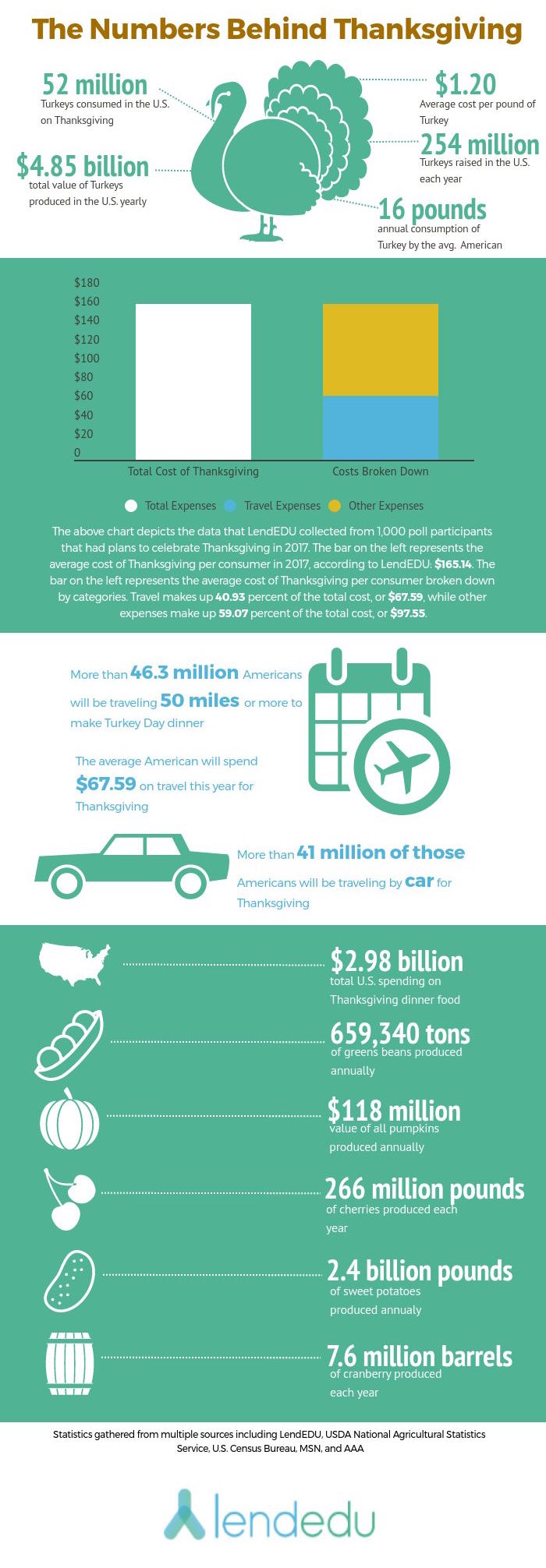For some more spirited Americans, the holiday season begins with Halloween. But for most, the true holiday season begins on the fourth Thursday of November: Thanksgiving.
For starters, Thanksgiving differs from Halloween in that it is a federal holiday, which means almost all of us are getting two days off work. But, Thanksgiving also feels like the real kick-off to the holiday season because we get to spend time with family, the climate has finally changed for the colder, and Christmas tunes begin blaring on the radio.
Plus, you have a TV schedule that includes the Macy’s Thanksgiving Day Parade, the pardoning of the presidential turkey, and NFL football.
Sounds like the holiday season to me.
But, everything in life comes at a price, and Thanksgiving, however joyous of an occasion it may be, is no exception to that rule.
In 2017, How Much Will the Average American Spend on Thanksgiving?
To develop a financial measuring stick for 2017’s Turkey Day, LendEDU polled 1,000 American consumers ages 18 and up that had plans to celebrate Thanksgiving this year.
Simply enough, we asked the 1,000 respondents the following question: “How much do you expect to spend celebrating Thanksgiving this year?”
From our responses, we calculated the average cost of Thanksgiving for the American consumer in 2017. As the bar graph above depicts, the average celebrator of Thanksgiving will be spending $165.14 on Turkey Day this year.
Additionally, we asked respondents to estimate how much of their Thanksgiving expenditure will be due to traveling costs. Traveling costs could have been anything including the price of plane tickets, gas money, bus tickets, hotel expenses, etc.
Costs associated with traveling accounted for 40.93 percent of the total money expected to be spent on Thanksgiving. Assuming our numbers are an accurate representation of the average American’s consumer behavior, that means the average celebrator of Thanksgiving will be spending $67.59 on travel expenses. The total expenditure for all other costs equates to $97.55.
While these numbers may come as a surprise to some, it must be remembered that the total Thanksgiving expenditure of $165.14 was an average figure, accounting for both ends of the cost spectrum. If respondents are planning to host Turkey Day this year, then their bills will be considerably higher than the average guest. A host must supply the majority of the food, libations, and decorations. Even a guest, whose total Thanksgiving cost is likely on the low-end, is usually expected to contribute to the Turkey Day festivities. It is in good taste for a guest to supply one dish for each course of the Thanksgiving feast, which could become a rather expensive token of gratitude.
Traveling costs making up the plurality of the total Thanksgiving expenditure came as no surprise, however. Because of the family-orientated nature of Turkey Day, the fourth Thursday of November becomes one of the busiest travel days of the entire year. Those who require a plane ticket or a hotel room fall on the high side of the spectrum. For local commuters, paying for gas or a bus ticket can still be quite costly, which is why it is important to always book in advance!

Methodology
All data that is seen in this report came from a poll commissioned by LendEDU and conducted online by online polling company Pollfish. In total, 1,000 Americans ages 18 and up were polled on two questions pertaining to Thanksgiving.
Respondents had to answer a screener question with the correct answer to ensure they were celebrating Thanksgiving in 2017. Poll participants were given the opportunity to enter in an exact dollar amount when they were answering how much money they were anticipating to spend on Thanksgiving and travel-related expenses in 2017. After we collected 1,000 responses, we were able to average the responses together to get the average holiday expenditure. Respondents were also asked to enter in an exact proportion related to travel expenses on Thanksgiving, which was then averaged together.
This poll was conducted over a two-day span from October 26th, 2017 to October 27th 2017. All the statistics used in the infographic came from a combination of sources including LendEDU, the USDA National Agricultural Statistics Service, the U.S. Census Bureau, MSN, and AAA. Respondents were asked to answer all questions truthfully and to the best of their ability.
See more of LendEDU’s Research
About our contributors
-
 Written by Mike Brown
Written by Mike BrownMike Brown uses data from surveys and publicly available resources to identify emerging personal finance trends and tell unique stories.